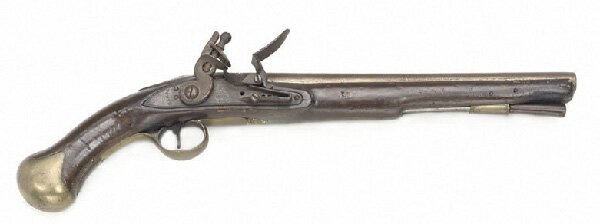One Shot Muzzle Loaders
The muzzle loaders were the standard pistol of the day. Muzzle loading involved shoving the powder and ball, along with paper wadding all the way down the barrel. Pistols loaded relatively easily due to the shortness of the barrel. A rifled barrel was harder to load than a smooth bore. Many people tried to find ways of making breech loaders but until the development of a self contained cartridge most breech loading weapons were marginal at best.
Muzzle loaders were loaded using a rammer or ramrod which pushed powder and ball down the barrel. In some cases the rammer was attached to the pistol with a swivel so that it could not be lost. The rammer was usually an integral part of any muzzle loaded firearm.
British Sea Service Flintlock

British Sea Service Flintlock, 18th Century
This model has the longer 14 inch barrel. Slightly shorter than a holster gun but longer than the Kentucky pistol of French Cavalry pistol. Note the heavy brass butt plate which allows the pistol to be used as a club. The pistol is very plain with little decoration, very typical of the factory produced pistols made for the British Crown's Navy.
Kentucky Pistol

Kentucky Pistol
The most common pistol of the Americas was the Kentucky Pistol. The pistol is a basic "belt pistol". It differs from the holster pistols in that it has a shorter barrel. The pirate would fasten his/her pistol to a belt, suspenders, or a sash using this hook or clasp. It was also quite common to pass the pistols through a belt or a simple loop of heavy material. This model fired a .45 caliber ball from a rifled barrel. The Kentucky pistols were made most often by German gunsmiths who settled in Pennsylvania.
Compare this to the French Cavalry Pistol, also favored among the pirates. The Kentucky pistol saw use from the early 1700s throughout the 1800s, eventually being converted to a percussion fire pistol.
French Cavalry Pistol

French Cavalry Pistol
Similar to the the Kentucky Pistol above, except it has a shorter barrel and less wood furniture, making it slightly lighter. The French pistol fired a larger caliber bullet but was not as accurate as the Kentucky pistol. The typical French Cavalry pistol fired a .65 caliber ball of lead.
Used throughout the 1700s and 1800s.
Holster or Saddle Pistol

Holster or Saddle Pistol. Note the long barrel.
Holster Pistols were long barrelled pistols that were carried in a saddle holster. The saddle holster hung from a horse's saddle, not from a person's belt. The common pistol holster as used today was uncommon during the 16th and 17th Century. Instead, a hook or clasp would adorn the side of the pistol opposite the lock mechanism and this allowed the pistol to be attached to a belt or sash.
Other Muzzle Loaded Pistols

A Swiss Muzzle Loader from the 18th Century

17th Century English Muzzle loaders, Single Shot

Spanish Miquelet-Lock, late 16th, Early 17th Century

17th Century German single shot muzzle loader

The only author and editor of all pages on the site. Most of what I write about is based on years of book reading on the topic. My first web page was published back in 1994.